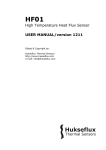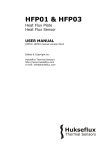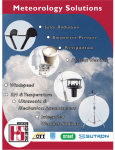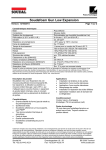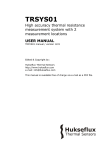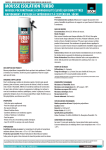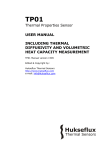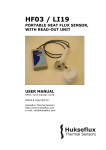Download Belt Heat Flux Sensor USER MANUAL
Transcript
BS01 Belt Heat Flux Sensor USER MANUAL BS01 manual version 0607 Edited & Copyright by: Hukseflux Thermal Sensors http://www.hukseflux.com e-mail: [email protected] Hukseflux Thermal Sensors Warning and safety issues Exerting force on the BS01 wiring can lead to permanent damage to the sensor. While watertight and pressure resistant, BS01 wiring to sensor connection is not particularly strong. The user is encouraged to avoid any unnecessary strain. Application of more than 12 Volt across the BS01 wiring can lead to permanent damage to the sensor. BS01 manual version 0607 page 2/26 Hukseflux Thermal Sensors Contents 1 1.1 1.2 2 3 4 5 6 7 8 9 10 11 11.1 11.2 11.3 11.4 List of symbols 4 Introduction 5 General Theory 8 General heat flux sensor theory 8 Detailed description of the measurement: resistance error, contact resistance, and temperature dependence 10 Application in simulated service testing 12 Specifications of BS01 13 Short user guide 16 Putting BS01 into operation 17 Installation of BS01 18 Maintenance of BS01 19 Requirements for data acquisition / amplification 20 Electrical connection of BS01 21 Data analysis and quality assurance 22 Appendices 23 Appendix on cable extension for BS01 23 Appendix on trouble shooting 24 Appendix on heat flux sensor calibration 25 CE declaration of conformity 26 BS01 manual version 0607 page 3/26 Hukseflux Thermal Sensors List of symbols Heat flux Thermal conductivity Voltage output Calibration factor Time Surface area Electrical resistance Thermal resistance Temperature Temperature dependence Sensitivity ϕ λ V Csen t A Re Rth T TD Esen W.m-2 W/m.K V W.m-2/µV s m2 Ω Km2/W °C %/K µV/W.m-2 Subscripts Property of the sensor Property of tube Property during calibration Property of the object on which BS01 is mounted BS01 manual version 0607 sen tube cal obj page 4/26 Hukseflux Thermal Sensors Introduction The BS01 is a large area flexible heat flux and temperature sensor for in-situ evaluation of the insulation value of pipes. With years of experience put into the design, it is the “standard” for pipe insulation testing for subsea oil pipes. The BS01 contains three sensitive areas and four integrated temperature sensors. Originally designed for “simulated service conditions testing” for subsea oil pipelines, it can withstand high hydrostatic pressures up to 110 bar and is (contrary to other sensors) completely water-tight. The main development effort has gone into the prevention of penetration of moisture into the sensor at high pressures. With sensors not specifically prepared for the high pressure, penetrated moisture will on the long term lead to instability of the sensor calibration. The sensor is provided with a mounting set for easy fixation, consisting of a cover and two springs. BS01 was originally designed by TNO TPD. Scientific publication about this sensor: D. Haldane (Heriot Watt University), F. van der Graaf, A.M. Lankhorst (TNO TPD): A direct Measurement System to obtain the Thermal Conductivity of Pipeline Insulation Coating Systems under Simulated Service Conditions, Offshore Technology Conference, 1999. In this publication the specific design considerations for heat flux sensors in simulated service tests are outlined. Hukseflux is specialised in themal analysis for pipeline insulation. In addition to the BS01 also matched thermocouples for differential temperature measurements, and specialised thermal conductivity measurement equipment for small plastic samples can be delivered. BS01 manual version 0607 page 5/26 Hukseflux Thermal Sensors Figure 0.1 BS01 on pipe during in service testing. 3 Cabling 4 Pipeline to be tested 5 BS01 mounted on pipeline (cover and springs for fixation are not shown) BS01 manual version 0607 page 6/26 Hukseflux Thermal Sensors 193.5 25 13 T3 100 T2 40 T1 T4 195 1.2 7 1. 2. 3. 4. 5. 6. 7. 8. 9. 10. 11. 12. 13. 14. 380 Figure 0.2 BS01 dimensions. Cable can be extended. 1 to 3 individual heat flux sensors, T1 to T4 temperature sensors (4 pieces), 4 Cabling, 1. to 6. heat flux sensor wiring, 7 to 14 temperature sensor wiring. See table 11.1. BS01 manual version 0607 page 7/26 Hukseflux Thermal Sensors 1 General Theory 1.1 General heat flux sensor theory As in most heat flux sensors, the actual sensors in BS01 are thermopiles. BS01 contains 3 heat flux sensors for improved quality assurance. A thermopile measures the differential temperature across the plastic body of BS01. Working completely passive, it generates a small output voltage that is proportional to the differential temperature that powers the heat flux travelling through it. (heat flux is proportional to the differential temperature divided by the local thermal conductivity of the heat flux sensor). Assuming that the heat flux is steady, that the thermal conductivity of the body is constant and that the sensor has negligible influence on the thermal flow pattern, the signals of BS01 are proportional to the local heat flux in Watt per square meter. Using HFP01 is easy. For readout one only needs an accurate voltmeter that works in the millivolt range. To convert the measured voltage Vsen in microvolt to a heat flux ϕ in W/m2, the voltage must be multiplied by the calibration factor Csen, a constant that is supplied with each individual sensor. In addition, for accurate measurements, a temperature correction must be applied. The applicable temperature is obtained by taking the average temperature as read out by the thermocouples that are incorporated in the BS01. ϕ = Csen (1+TD(T-Tcal)) Vsen 1.1.1 With TD the temperature dependence of the calibration factor in %/K and Tcal the reference temperature and the temperature T in K or degrees C. Csen is the calibration factor for the individual sensor, so Csen should be changed depending on the exact sensor. In the present configuration of the BS01 design, the TD typically is 0,17%/K and Tcal is mostly chosen to be 20 degrees C. In this case formula 1.1.1 becomes ϕ = Csen (1+0.0017(T-20)) Vsen 1.1.2 With T in degrees C and Vsen in microvolts. NOTE 1: application of formula 1.1.2 only after verification of the individual sensor calibration certificate. BS01 manual version 0607 page 8/26 Hukseflux Thermal Sensors NOTE 2: With most Hukseflux sensors the mathematics is based on the sensor sensitivity (reciprocal value of the calibration constant) rather than on the calibration constant. BS01 is an exception for historical reasons. Figure 1.1.1 General characteristics of a heat flux sensor as incorporated in BS01. When heat (6) is flowing through the sensor, the filling material (3) will act as a thermal resistance. Consequently the heat flow ϕ will go together with a temperature gradient across the sensor, creating a hot side (5) and a cold side (4). The majority of heat flux sensors is based on a thermopile; a number of thermocouples (1,2) connected in series. A single thermocouple will generate an output voltage that is proportional to the temperature difference between the joints (copper-constantan and constantan-copper). This temperature difference is, provided that errors are avoided, proportional to the heat flux, depending only on the thickness and the average thermal conductivity of the sensor. Using more thermocouples in series will enhance the output signal. In the picture the joints of a copper-constantan thermopile are alternatively placed on the hot- and the cold side of the sensor. The two different alloys are represented in different colours 1 and 2. The thermopile is embedded in a filling material, usually a plastic, in case of BS01 a special pressure resistant polyurethane. Each individual sensor will have its own calibration factor, Csen, usually expressed in Watt per square meter heat flux ϕ per 1 Volt output, Vsen. The flux is calculated ϕ= Vsen Csen, typically corrected for temperature. The calibration factor as well as the temperature dependence are determined at the manufacturer, and can be found on the calibration certificate that is supplied with each sensor. BS01 manual version 0607 page 9/26 Hukseflux Thermal Sensors 1.2 Detailed description of the measurement: resistance error, contact resistance, and temperature dependence Ignoring the temperature dependence, the heat flux is expressed as: ϕ = Vsen Csen 1.2.1 This paragraph offers a more detailed description of the heat flux measurement. It should be noted that the following theory for correcting for resistance errors usually is not applied. For BS01, usually one will work with formula 1.1.2. When mounting the sensor on an object with limited thermal resistance, the sensor thermal resistance itself might be significantly influencing the undisturbed heat flux. One part of the resulting error is called the resistance error, reflecting a change of the local total thermal resistance of the object. A first order correction of the measurement is: ϕ = (Rthobj+Rthsen ) V sen C sen (1+TD(T-Tcal)) / Rthobj 1.2.2 Figure 1.2.1 The resistance error: a heat flux sensor (2) increases or decreases the total thermal resistance of the object on which it is mounted (1) or in which it is incorporated. This can lead either to a larger of smaller (increase of or decrease of the- ) heat flux (3).In case of mounting BS01 on a pipeline, the local thermal resistance is always increased. BS01 manual version 0607 page 10/26 Hukseflux Thermal Sensors The correction of 1.2.2 is often applied with thin or not very well isolated tube walls. The sensor thermal resistance is about 6.10-3 K.m2/W. This should be less than 1% of the thermal resistance of the insulation material. So, the insulation material should have a thermal resistance higher than 0.6 K.m2/W. Because of the cilyndrical shape the thermal resistance of the insulation layer is given by: R = (r2/ λ ) ln (r2 / r1 ) 1.2.3 r2 = radius of pipe plus insulation r1 = radius of pipe λ = thermal conductivity of insulation r1 is typically 160 mm. So r2 should be higher than 240 mm, resulting in a minimum insulation material thickness of 80 mm. Apart from the sensor's own thermal resistance, also contact resistances between sensor and surrounding material are demanding special attention. Essentially any air gaps add to the sensor thermal resistance, at the same time increasing the deflection error in an unpredictable way. In all cases the contact between sensor and surrounding material should be as well and as stable as possible, so that it is not influencing the measurement. It should be noted that the conductivity of air is approximately 0.02 W/m.K, ten times smaller than that of the heat flux sensor. It follows that air gaps form major contact resistances, and that avoiding the occurrence of significant air gaps should be a priority whenever heat flux sensors are installed. BS01 manual version 0607 page 11/26 Hukseflux Thermal Sensors 2 Application in simulated service testing BS01 has been designed for simulated service testing of oil pipelines. The conditions of this kind of testing are rather specific. In particular the sensor must be water tight up to high pressures, have a thermal resistance as well as sufficient sensitivity. All these were taken into consideration during BS01 design. In addition there is a need for quality assurance, which is covered by incorporating 3 separate heat flux sensors as well as 4 separate temperature sensors. Internal pipe diameter Steel wall thickness Coating thickness Internal temperature External temperature Heat flux Coating thermal conductivity 250 mm 30 mm 100 mm 110 degrees C 10 degrees C 100 W/m2 0.16 W/mK Table 2.1 Typical condutions for simulated service testing of oil pipelines. BS01 manual version 0607 page 12/26 Hukseflux Thermal Sensors 3 Specifications of BS01 BS01 is a large area flexible heat flux and temperature sensor. It measures with 3 separate sensors the local heat flux perpendicular to the sensor surface on the object on which it is mounted, as well as its surface temperature with 4 thermocouples. It can only be used in combination with a suitable measurement system. BS01 is supplied with a cover and spring for installation on a typical insulated tube. GENERAL SPECIFICATIONS Specified Heat flux in W/m2 perpendicular to the measurements sensor surface. Surface temperature in K Heat flux measurement 3 separate heat flux sensors Temperature 4 type K thermocouples measurement Installation See the product manual for recommendations. Temperature range 0 to +100 degrees C CE requirements BS01 complies with CE directives Protection Class IP65 Pressure range 0-110 bar the sensor has successfully been used up to 200 bar, but this application is not covered by factory warranty. Cover dimensions 140 x 360 mm Spring dimensions length 390 mm MEASUREMENT SPECIFICATIONS Expected accuracy (to Within 2.5% 50 degrees C) Temperature 0.17%/ °C (exact value on calibration dependence of the certificate) calibration coefficient (TD) SENSOR SPECIFICATIONS Calibration constant 0.02 W m-2 /µV (exact value for each Csen (nominal) single sensor on calibration certificate) Tcal =20 °C Sensitivity Esen 50 µV /W m-2 (nominal) (this parameter is normally not used with BS01 calculations) Thermal conductivity 0.20 W/mK +/- 10% Table 3.1 BS01 specifications part 1 (continued on the 2 next pages) BS01 manual version 0607 page 13/26 Hukseflux Thermal Sensors Sensor thermal resistance Rth Sensitivity to pressure Non linearity Range Sensitivity to bending Non stability Required readout Expected voltage output Power required Internal electrical resistance (single heat flux sensor) Required programming Sensitive part dimensions Connector block height Cable length, diameter Flexibility Weight including 3 m cable 6 10 -3 Km2/W Sensor construction has been optimised to show no significant pressure dependence. This has been empirically confirmed. Sensor construction has been optimised to show no significant non-linearity. This has been empirically confirmed. to + 2000 Wm-2 Sensor construction has been optimised to show no significant sensitivity to bending. This has been empirically confirmed. < 1% change per year For heat flux measurement. 3 differential voltage channel or possibly (less ideal) 3 single ended voltage channel. When having a lack of input channels, it can be considered to put several heat flux sensors in series, while working with the average sensitivity and several thermocouples in parallel, working as if it is a single thermocouple. Application in typical simulated service test: -10 to - + 20 mV Zero (passive sensor) 2 kOhm (nominal) including cable resistance For each sensor individual sensor: ϕ = Csen (1-TD(T-Tcal)) Vsen 195 x 100 (x 1.2 mm) 7 mm 3 meters, 5 mm 30 mm minimum radius 2 kg, including metal shield on cable Table 3.1 BS01 specifications part 2 (continued on the next page) BS01 manual version 0607 page 14/26 Hukseflux Thermal Sensors CALIBRATION Calibration traceability to electrical power and surface area DIN52612, ISO8302, ASTM C177 Every 2 years Recalibration interval Options Extended cable Consult manufacturer Matched thermocouples Consult manufacturer for readout of temperature differential across the insulation Table 3.1 BS01 specifications part 3. BS01 manual version 0607 page 15/26 Hukseflux Thermal Sensors 4 Short user guide Preferably one should read the introduction and first chapters to get familiarised with the heat flux measurement and the related error sources. In particular it is recommended to estimate the order of magnitude of the resistance error. The sensor should be installed following the directions of the next paragraphs. Essentially this requires a data logger and control system capable of readout of small voltages, and thermocouples and capability to perform multiplications and divisions of formula 1.1.1. The first step that is described in paragraph 5 is an indoor test. The purpose of this test is to see if the sensor works. BS01 manual version 0607 page 16/26 Hukseflux Thermal Sensors 5 Putting BS01 into operation It is recommended to test the sensor functionality by checking the impedance of the sensors and thermocouples, and by checking if the sensor works, according to the following table: (estimated time needed: 15 minutes) Warning: during this part of the test, please put the sensor in a thermally quiet surrounding because a sensor that generates a significant signal will disturb the measurement. The typical sensor impedance is 2 kohms. Infinite indicates a broken circuit; zero indicates a short circuit. Check the impedance of the heat flux sensors. Use a multimeter at the 10 kilo Ohms range. Measure at the sensor resistance first with one polarity, than reverse polarity. Take the average value. Repeat for each sensor. Check if the sensor reacts to heat flux. Use a multimeter at the millivolt range. Measure at the sensor output. Generate a signal by touching the thermopiles with the hand at one side, possibly with the other side in contact with a relatively cold object. Check if the thermocouples are in good condition. If possible use a thermocouple readout unit. Generate a change in signal by touching the thermocouple locations with the hand. The sensor should react by generating a millivolt output signal. Polarity can be reversed by touching the sensor at the opposite side. The thermocouple reading should show a realistic value, and should react to changes. Otherwise measure the resistance of the thermocouples, this should be a few Ohms. Table 6.1 Checking the functionality of the sensor. The procedure offers a simple test to get a better feeling how BS01 works, and a check if the sensor is OK. The programming of data loggers is the responsibility of the user. Please contact the supplier to see if directions for use with your system are available. BS01 manual version 0607 page 17/26 Hukseflux Thermal Sensors 6 Installation of BS01 BS01 is generally installed on the surface, at the location where one wants to measure. The more even the surface on which BS01 is placed the better. Care should be taken to prevent the creation of air gaps between sensor and tube. Recommended contact material for temporary installation is thermal paste of Dow Corning. In case of permanent installation or high pressure testing, it is recommended to apply silicone glue in a thin layer. In case of simulated service testing, and using the cover with springs, one could also choose to work without any contact material; water takes over this function once the sensor is submerged. It is recommended to fix the location of the sensor by using the cover and springs that are supplied with the sensor. Use of these is self explanatory. Table 7.1 General recommendations for installation of BS01. In case of exceptional applications, please contact Hukseflux. BS01 manual version 0607 page 18/26 Hukseflux Thermal Sensors 7 Maintenance of BS01 Once installed, BS01 is essentially maintenance free. Usually errors in functionality will appear as unreasonably large or small measured values. As a general rule, this means that a critical review of the measured data is the best form of maintenance. At regular intervals the quality of the cables can be checked. On a 2 yearly interval the calibration can be checked in an indoor facility. BS01 manual version 0607 page 19/26 Hukseflux Thermal Sensors 8 Requirements for data acquisition / amplification Below table shows a listing of specifications of the data acquisition and amplification system for heat flux measurement. In most experiments there will be an additional need to perform measurements of the temperature difference across tube insulation. This measurement is typically performed using two matched thermocouples. These also can be supplied by Hukseflux. The readout required for one pair (two) of such sensors is equal to one heat flux and one temperature channel. For heat flux measurement. Capability to measure microvolt signals For temperature measurement. Capability to perform measurements of thermocouple type K Capability for the data logger or the software Typical readout for differential temperature, performed by tow matched thermocouples type K (not part of BS01) 3 differential voltage channel or possibly (less ideal) 3 single ended voltage channel. When having a lack of input channels, it can be considered to put several heat flux sensors in series, while working with the average sensitivity Preferably: 5 microvolt accuracy Minimum requirement: 50 microvolt accuracy (both across the entire expected temperature range of the acquisition / amplification equipment) 4 Type K thermocouple signals. These should be read-out with an accuracy of about and several thermocouples in parallel, working as if it is a single thermocouple. To store data, to perform calculations for each sensor individual sensor: ϕ = Csen (1-TD(T-Tcal)) Vsen One differential voltage channel and one thermocouple channel. Table 10.1 Requirements for data acquisition and amplification equipment. BS01 manual version 0607 page 20/26 Hukseflux Thermal Sensors 9 Electrical connection of BS01 In order to operate, BS01 should be connected to a measurement and system as described above. A typical connection is shown in table 9.1. BS01 is a passive sensor that does not need any power. Cables generally act as a source of distortion, by picking up capacitive noise. It is a general recommendation to keep the distance between data logger or amplifier and sensor as short as possible. For cable extension, see the appendix on this subject. Wire Colour Measurement system Sensor 1 output + Sensor 1 output - white white/red Sensor 2 output + Sensor 2 output - Black Black/white Sensor 3 output + Sensor 3 output - Brown Brown/white Voltage Voltage ground Voltage Voltage ground Voltage Voltage ground Thermocouple + Marking 1,2,3,4 Thermocouple – Marking 1,2,3,4 Yellow Thermocouple input + Red Thermocouple input - input + input - or input + input - or input + input - or Table 9.1 The electrical connection of BS01. The heat flux sensor outputs usually are connected to differential voltage inputs. Thermocouple location see figure 0.2 When using more than one sensor and having a lack of input channels, see the appendix on requirements for data acquisition. BS01 manual version 0607 page 21/26 Hukseflux Thermal Sensors 10 Data analysis and quality assurance It is recommended to ensure data quality by storage of all raw data in microvolts (both of the sensors and from the thermocouples). Measurement quality is further enhanced by careful review of the data. In particular the data of the different heat flux measurement results should deviate by no more than 2%, and the temperature data should differ by no more than 0.5 degrees C. In addition it is suggested to verify that the measured data of heat flux as well as termperature are stable within 1% or 0.5 degrees over at least 30 minutes. BS01 manual version 0607 page 22/26 Hukseflux Thermal Sensors 11 Appendices 11.1 Appendix on cable extension for BS01 BS01 is equipped with one tube-type, pressure resistant and water tight cable containing all 14 leads. This cable has a watertight connection to the sensor. It is a general recommendation to keep the distance between data logger or amplifier and sensor as short as possible. Cables generally act as a source of distortion, by picking up capacitive noise. Longer pressure / water resistant cable can be ordered during manufacturing. For use outside the pressure vessel, BS01 cable can be extended by thicker, more mechanically robust cabling without any problem to 50 meters. If done properly, the sensor signal, although small, will not significantly degrade. Cable for heat flux Core resistance Outer diameter Connection 6-wire shielded, copper core (for 3 sensor signals) 0.1 Ω/m or lower (preferred) 5-7 mm Soldering is preferred. Clamping or good quality connectors can also be used. Depending on the circumstances mechanical tension reliefs can be designed. Table 11.1.1 Specifications for heat flux cable extension of BS01. Cable for 3 pair shielded, type K extension cable heat flux Connection Clamping is preferred. Depending on the circumstances mechanical tension reliefs can be designed. Table 11.1.2 Specifications for thermocouple cable extension of BS01. BS01 manual version 0607 page 23/26 Hukseflux Thermal Sensors 11.2 Appendix on trouble shooting This paragraph contains information that can be used to make a diagnosis whenever the sensor does not function. The heat flux sensor or temperature sensor does not give any signal Measure the impedance across the sensor wires. This should be around 2 kohms for the heat flux sensor, several ohms for a thermocouple. If it is closer to zero there is a short circuit (check the wiring). If it is infinite, there is a broken contact (check the wiring). This check can be done even when the sensor is in operation. Check if the sensor reacts to an enforced heat flux or temperature change. In order enforce a flux, it is suggested to mount the sensor on a piece of metal, create a thermal connection with some thermal paste, that is used in electronics (if not available toothpaste will also do), and to use a lamp as a thermal source. A 100 Watt lamp mounted at 10 cm distance should give a definite reaction of both heat flux and temperature Check the data acquisition by applying a mV source to the input in the 1 mV range. Check if the right calibration factor is entered into The heat flux sensor signal is the algorithm. Please note that each sensor has its own individual calibration factor. unrealistically Check if the voltage reading is multiplied by the high or low. calibration factor by review of the algorithm. Check if the temperature dependence is correctly applied. Check if the mounting of the sensor still is in good order. Check the condition of the leads at the logger. Check the cabling condition looking for cable breaks. Check the range of the data logger; heat flux could be out of range Check the data acquisition by applying a mV source to it in the 1 mV range. Check the presence of strong sources of The sensor electromagnetic radiation (radar, radio etc.) signal shows Check the condition of the shielding. unexpected Check the condition of the sensor cable. variations Table 11.2.1 Trouble shooting for BS01. BS01 manual version 0607 page 24/26 Hukseflux Thermal Sensors 11.3 Appendix on heat flux sensor calibration The calibration of BS01 is performed using a guarded hot plate. In this configuration the calibration is traceable to heater power and surface area. The calibration is performed at several temperatures to verify the temperature dependence. The calibration reference conditions for BS01 calibration at TNO / TPD are: Temperature: 20 °C Heat Flux: 10 W/m2 BS01 manual version 0607 page 25/26 Hukseflux Thermal Sensors 11.4 CE declaration of conformity According to EC guidelines 89/336/EEC, 73/23/EEC and 93/68/EEC We: Hukseflux Thermal Sensors Declare that the product: BS01 Is in conformity with the following standards: Emissions: Radiated: Conducted: Immunity: EN 55022: 1987 Class A EN 55022: 1987 Class B ESD IEC 801-2; 1984 8kV air discharge RF IEC 808-3; 1984 3 V/m, 27-500 MHz EFT IEC 801-4; 1988 1 kV mains, 500V other Delft, January 2006 BS01 manual version 0607 page 26/26


























